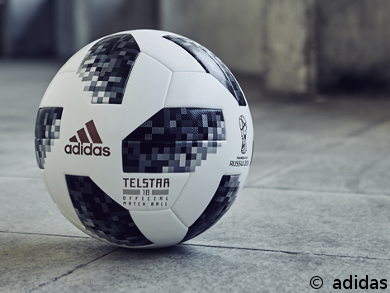Telstar 18 (Star of Television 2018) is the official match ball of the World Cup 2018 in Russia. The ball, made by adidas, is not made up of the traditional hexagons and pentagons, but of irregular elements with asymmetrical prints. Depending on the light conditions, the flying ball should be quite an unusual sight.
The surface of the ball is thermally bonded to achieve a seamless surface and contains specifically textured plastic which makes guiding the ball easier, especially when the field is wet. Directly underneath the outer cover of the ball is a sponge rubber layer. It is made from the bio-based EPDM rubber (ethylene-propylene-diene monomer) Keltan Eco 6950 produced by ARLANXEO, a 50/50-joint venture of LANXESS and Saudi Aramco. Keltan Eco 6950 has an amorphous structure and high crosslinking density. Keltan Eco is the world’s first EPDM rubber manufactured using bio-based ethylene made from sugarcane via conversion to bioethanol and subsequent dehydration. Depending on the ethylene content of each rubber grade, the proportion of bio-based material ranges between 50 and 70 %. The sponge rubber layer must be elastic and resilient to serve as a moldable cushion for the ball and support optimal bounce characteristics.
As in previous years, the ball had to pass the quality test program of FIFA (Fédération Internationale de Football Association). Criteria include that the ball must only absorb a minimal amount of liquid when crushed 250 times in a water tank, hold its air, always jumps back to the same height when it impacts from a height of 2 m, and it must retain its shape even if shot against a steel wall 2,000 times at 50 km/h. The ball must be a perfect sphere which is measured at 4,000 points.
- ARLANXEO, Maastricht, The Netherlands
- adidas AG, Herzogenaurach, Germany
- Swiss Federal Laboratories for Materials Science and Technology (Empa), Dübendorf, Switzerland
Also of Interest
- World Cup Ball Chemistry Quiz,
ChemViews Mag. 2018.
Test your knowledge of the World Cup 2018 ball - The Science of Football,
ChemViews Mag. 2012.
DOI: 10.1002/chemv.201200063 - Chemistry of Brazuca, the World Cup Football,
ChemistryViews.org 2014.
The 2014 World Cup football Brazuca has five polyurethane layers which make for its uniqueness








